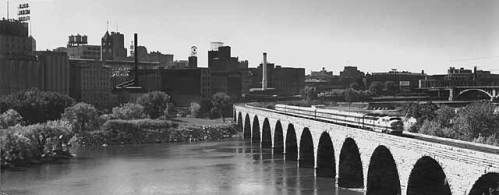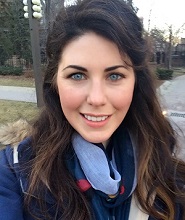Article by Becky Fillinger
Mississippi National River and Recreation Area (MNRRA) Superintendent John Anfinson will retire at the end of December, after spending twenty impactful years at the National Park Service. We talked to him about his career, influences and what the future holds for one of our most visible river stewards.

Q: In a Star Tribune interview in 2015 you said: “Our biggest challenge is that people don’t know we exist here, and they don’t know why it matters,” he said. “We hope to change that.” Tell us what you’ve done to make people more aware of the only national park unit focused on the Mississippi River.
A: One thing I have done is to increase our visitation. Our Mississippi River Visitor Center, in the entry area of the Science Museum of Minnesota, captured about 60,000 visitors annually, less than 10% of the Museum’s visitors. While in the Museum’s lobby, most people didn’t see it, and some thought our welcome desk was a security desk.
So with substantial leadership from Mississippi Park Connection, our philanthropic partner, and with Centennial Challenge Funding from the National Park Service (NPS), we completely revamped it. We reopened on August 25, 2016, the 100th anniversary of the NPS. In the first year, we saw over 190,000 visitors and have settled into an average of about 160,000.
 Mississippi River Visitor Center at the Science Museum of Minnesota
Mississippi River Visitor Center at the Science Museum of Minnesota
On June 10, 2015, the Upper St. Anthony Falls Lock in downtown Minneapolis permanently closed to navigation, and the St. Paul District, Corps of Engineers, asked if we wanted to take over their visitor center. How could I refuse? The lock has the most spectacular views of St. Anthony Falls and Mississippi River on the river’s west bank. It sits at the west end of the Stone Arch Bridge, which sees over two million visitors annually, and it is in the heart of the St. Anthony Falls Historic District.
While the Corps averaged about 2,000 visitors per year, we have steadily grown our numbers and welcomed 25,000 in 2019. COVID-19, of course, seriously reduced this year’s visitation, but once we open again in 2021, I expect visitation to rise well above 25,000. We were able to use a new access point at the end of the bridge this year that takes visitor directly onto the lock surface. We hope to use that every year. Phase I of Water Works will open sometime next summer, bringing many more people to the west side near our entrance.
Our restoration work at Coldwater Spring has turned it into a sanctuary for wildlife and those seeking escape from the hectic pace of urban life. Counting the Minnehaha Trail, which runs along the east side, and visitors who walk through the site, we see over 100,000 visitors here annually, and we hope to increase that number.
Overall, the park’s visitation has increased from 112,000 in 2015 to over 430,000 in 2018. We have gone from the 26th most visited park of the 61 in the 13-state Midwest Region to 14th. If Friends of the Falls’ vision for a world class experience at the repurposed Upper Lock comes to fruition, and we can establish a new park headquarters and River Learning Center at Watergate Marina, we could easily move into the top 10.
Q: You’ve also said: “If you want to see how to do riverfront development right, you have to go to the Twin Cities.” Can you tell us more about your thoughts on this?
A: When people look at the Grand Canyon or Mesa Verde or think about storied places like Gettysburg, they immediately get why they are among the pantheon of America’s national parks. If asked, few could explain why the Mississippi National River and Recreation Area (MNRRA) stands with them.
Not every park is the Grand Canyon or Mesa Verde. The NPS tries to capture the best representative examples of America’s greatest places and stories. The Mississippi National River and Recreation Area is the only national park whose mission is the Mississippi River. We are different from other parks. We have different stories and different landscapes, but our stories are every bit part of the national narrative, and our resources are essential to our national identity.
We have to grow into the idea that we are NPS worthy, and we have to do that by fulfilling the mission Congress gave us to guide orderly development along the Mississippi River. This means developing along the river in a way that is worthy of one of the world’s greatest rivers and of being part of the National Park System. If we do that consistently and for long enough, people from around the country and world will come here because they want to see and learn what developing along great rivers in the right way looks like. This means cities and developers might have to forgo projects that don’t rise to this level, but if the cities of the MNRRA corridor can let go of short-term gains, the economic value of how special the MNRRA corridor will become cannot be overestimated.
Q: I recently took a guided hike at Coldwater Spring – what a hidden gem! Can you tell us about the redevelopment of this property?
A: From 1949 to 1996, the Bureau of Mines expanded its operations at Coldwater Spring, as one of 11 regional centers studying mining processes and safety. In 1996, Congress quit funding the Bureau, and the site was abandoned. Over the next 14 years, the dozen buildings there began deteriorating and were extensively vandalized. As the Bureau of Mines had been a bureau within the Department of the Interior, the Department directed the National Park Service to conduct an Environmental Impact Statement for the disposition of the site, and in 2010, the Midwest Region Direct signed the Record of Decision transferring the land to NPS for management by MNRRA and directing the park to restore the land. In September 2010, after removing all the buildings, roads and parking lots, Coldwater Spring opened to the public. In 2018, we successfully completed the first prairie burn, and within weeks the prairie came back more lush than ever.
 Prairie burn
Prairie burn





A number of tribes, including some Dakota tribes, have declared it a sacred site, which the park has recognized, and many others have found it a sanctuary from the rush of urban life. The restored oak savanna, over 400 trees planted by our staff and volunteers, is also drawing a wide array of migratory birds and other wildlife.
Q: How has COVID-19 impacted your last year as Superintendent of the Mississippi National River and Recreation Area (MNRRA)?
A: COVID-19 has made for an intense year, and I have worked to bring the park through the pandemic.
Once Governor Tim Walz issued his stay at home order, many staff did not want to leave their homes. I had to work closely with staff to develop clear protocols for conducting programs, field work and volunteer activities. We had to figure out how to bring on our summer seasonal employees and use them as effectively as possible and give them a meaningful experience. We developed a return to office plan, which we hope to implement by spring, if enough people have been vaccinated.
Our Mississippi River Visitor Center (MRVC) in the Science Museum closed on March 13, with the Museum, and we had to consider how to engage the public in other ways. One of those ways is called Coffee with a Ranger, a weekly program with a park ranger talking about some topic relevant to the park. We have had 65,731 views of these programs as of September 11. We were one of the first parks to bring in a live sign language interpreter. This program was so successful, staff from Yellowstone and Yosemite sat in on our virtual training sessions on how to put on the program.
We reopened the MRVC on September 4, when the Science Museum opened again, and I had to work closely with staff on a risk/mitigation assessment for re-opening. I joined my visitor center manager and his staff on two calls to assure that they would be safe. When they were still clearly nervous, I arranged for one of our Midwest Region Public Health Officers to join a call with them, which largely allayed their concerns. Of course, our visitor center closed again with the Governor’s new restrictions.
While we normally open the Upper St. Anthony Falls Lock to visitation over the Memorial Day weekend, we could not this year. So, we worked with the Corps of Engineers on how to open the outside areas, principally the large lock surface. Again, I worked with staff on the risk/mitigation plan. On July 24, we opened the lock to visitors, using a new entry point. Staffing this visitor center was especially complex, given that we rely heavily on volunteers, who are generally retired and older. Our safety protocols, however, successfully assured many of them they would be safe. While not seeing the numbers we have in past years, we have had good visitation and have learned new things about how we will operate in the future, with and without COVID-19.
I also have to call out our Formal Education programs. Last spring, we had more students and schools signed up for our signature Big River Journey Program than ever before. In this program, we use paddleboats as classrooms, bringing in partners and volunteer to help. We instantly had to shift to putting this program online. Within six weeks, we had developed the online course in partnership with Hamline University and MPC. Big River Journey had 6,378 unique visitors, and the Formal Education program staff had engaged 7,649 students overall as of September 11, including 647 classroom visits and 624 unique visits to our Living River online program.
 Southside Aces at Upper St. Anthony Falls Lock in 2019
Southside Aces at Upper St. Anthony Falls Lock in 2019
Q: What’s the most incredible wildlife 1:1 encounter you experienced?
A: In October of 2018, I headed west on a vacation with the goal of getting to Glacier National Park for the annual Friends Alliance (NPS philanthropic partner organizations) meeting. On the way, I camped two nights on a high mesa in Colorado National Monument. The first day I went on a long hike in the valleys below the mesa, hoping to see some Bighorn sheep. Halfway into my hike I hadn’t seen any, and dark storm clouds began coming over the mesa from the west. As the storm broke, with a wind that drove the pouring rain sideways, I found shelter under a large boulder. Once the storm passed, I resumed my hike and looked up the side of the mesa. Huddled against the sheer wall were about a dozen Bighorns. The storm had brought them all together. As I continued walking and watching them and them watching me, they started working their way down toward me, stopping at a comfortable distance.
 Can you spot the Bighorn sheep?
Can you spot the Bighorn sheep?
 Here's a closer look at the Bighorn
Here's a closer look at the Bighorn
Q: In 2005 you were one of ten U.S. delegates to the joint U.S./Dutch symposium on water resources in The Hague, Netherlands sponsored by the Institute for Water Resources and the Rijkswaterstaat. How did that come about and what came from the conference?
A: The Rijkswaterstaat is the Dutch equivalent of the U.S. Army Corps of Engineers, and the two agencies wanted to examine the history of water resource management in the two countries. Each selected 10 representatives to meet in The Hague. As I had worked for the Corps from 1980 to 2000 and had published The River We Have Wrought, A History of the Upper Mississippi River in 2003, I was selected to represent the Mississippi River. I quickly realized that the Rhine River in the Netherlands resembles the lower Mississippi River and not the upper. I also learned that their system of government doesn’t allow for the kind of pork barrel politics that has funded much of America’s water infrastructure. So, their system is more strategic than political in how it approves and funds water resource projects.
Q: You earned a Ph.D. in American Indian history at the U. What drove your interest in Native American history?
A: My father was fascinated with history and the American West. We headed west or southwest for all our family vacations. Studying history and anthropology came easy to me, as did biology. I think I was also influenced by one of my older brothers who had majored in archeology. I specifically became interested in the fur trade, the exchange of European and American goods for beaver and other furs. While economic anthropology became a primary lens for studying the fur trade, I also became aware of the environmental impacts the fur trade had.
I had wanted to be an ecologist coming out of high school, but math and chemistry never clicked for me. So, I finally accepted what I was best at. Over my time with the Corps of Engineers, I began working on Mississippi River projects, and the river’s history, especially how the Corps had transformed it, became my primary research and writing interest. I then realized that I could combine my interest in history and biology and pursue environmental history, which has been my main focus for the last 20 years.
Q: Tell us about the River Learning Center (RLC).
A: As the only National Park whose mission is the Mississippi River, we are the Mississippi River’s National Park. So, it makes sense that our headquarters and our education and interpretation base should be near the river. Our current headquarters is downtown St. Paul, in a 32-story-tall apartment building. Whenever we want to conduct one of our river programs, we have to travel to another location. At the Watergate Marina site, in Crosby Farm Regional Park, staff could walk out the door and lead tours of the floodplain forest, get people into canoes and kayaks, have them board a pontoon boat or paddleboat, or they could jump onto the bike trail running through the park. We wouldn’t have be borrow some other organization’s classrooms.
The River Learning Center (RLC) project is a partnership with the City of Saint Paul, Great River Passage Conservancy, Mississippi Park Connection and Wilderness Inquiry. The City sought funding through the bonding bill in the last Legislative session but did not get it. They will try again next year. The other partners are raising the $600,000 needed for schematic design. Our rent, paid by the General Services Administration, will go for the park’s office and programming space in the new building, helping with the yearly and long-term costs.
The RLC will not replace our traditional NPS visitor center in the Science Museum, since RLC will focus on river experiences on and along the Mississippi. We will continue connecting with local audiences, especially youth, but we also hope to attract national and international visitors. The Minneapolis/Saint Paul International Airport is only about 10 minutes away, and the Mall of America about 15.
The RLC will be located at the nexus of importance geological, geographical, natural and historical stories. It will be at the confluence of the Mississippi and Minnesota rivers, a place sacred to some Dakota tribes. At the confluence, the big river begins, and the Gorge, the narrow canyon of the Mississippi River above the confluence ends. Combined with Hidden Falls Regional Park, the RLC will be in the largest natural park setting in Saint Paul and a pivotal nesting and resting for birds that use the Mississippi River flyway. The bluff running along the east side features geologic layers near one-half billion years old.
Q: What is the next chapter for John Anfinson?
A: I plan to focus deeply on the biggest river issues in the Twin Cities metro area and provide substantive environmental historical context for them. Among the most important are the Corps disposition studies for the three locks and dams in the heart of the area. The Lock & Dam No. 1 and Lower St. Anthony Falls Lock & Dam study, for example, has to examine dam removal as an alternative, and I’ve seen and heard a lot of speculation on what the undammed river would look like. I plan to provide a thorough historical context for that conversation that will eliminate some of the guesswork.
I will also stay involved with some organizations that I now sit on boards or commissions for, including Friends of the Mississippi River, Minnesota and National Mississippi River Parkway Commissions, and the Minnesota Aquatic Invasive Species Citizen Advisory Board. I also plan to work more closely with the National Parks Conservation Association locally.
Of course, I hope to travel, play more golf (as a way to enjoy time with family and friends), get out to the family cabin in western Minnesota more often and generally slow down a bit.
Q: You said, “Far too often, I have found it a challenge to get cities, individuals, developers, and the public to recognize how important the Mississippi River is in the Twin Cities and how special it is to have National Park status. I hope that someday, most will understand.” Can you leave us with your suggestions on how to bring these parties together for a discussion on National Park status?
When I give presentations to communities in our corridor, I ask the audience if they think of their community as a gateway city to a National Park, like Bar Harbor, Maine, is to Acadia or Cody, Wyoming, is to Yellowstone. Of course, they don’t. It has never occurred to them, which stems from not knowing the park exists or why it is just as important in its own right as Acadia and Yellowstone. Every community in the MNRRA is a gateway to the stories and experiences this National Park has to offer. Why wouldn’t they take advantage of that to draw tourism and new residents?
Greater MSP did a study a while back looking at what holds and attracts young workers to metropolitan areas. They recognized that Minnesota was losing more young talent than it was attracting. They learned that the number one draw was access to outdoor recreation. How many cities have such direct access to outdoor recreation as the Twin Cities? I believe a greater emphasis on the presence and value of the Mississippi National River and Recreation Area could help hold young workers here and sell the Twin Cities to those from other states. Better marketing of the Mississippi River and National Park could also draw more tourists. Of course, we have to offer a river that features clean water, recreational access and great riverfront development, so that we don’t disappoint them.
 The Paddle Share program is a perfect way to enjoy the Mississippi River
The Paddle Share program is a perfect way to enjoy the Mississippi River
 Tuesday, December 15, 2020 at 7:58AM |
Tuesday, December 15, 2020 at 7:58AM |  Kim Eslinger |
Kim Eslinger | 




















































